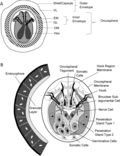Oncosphere
Oncosphere is the larval form of certain tapeworms, specifically those belonging to the order Cyclophyllidea. This stage of the tapeworm's life cycle is also known as the hexacanth (meaning "six-hooked") stage, due to the presence of six hooks on the larva's body. The oncosphere is typically ingested by an intermediate host animal, where it can develop into a cysticercus or other form of larval tapeworm.
Life Cycle[edit]
The life cycle of a tapeworm begins when the adult worm, residing in the intestine of its definitive host, releases eggs into the host's feces. These eggs, each containing an oncosphere, are then ingested by an intermediate host. Once inside the intermediate host's body, the oncosphere hatches from the egg and uses its hooks to burrow through the intestinal wall and into the host's body tissues. Here, it develops into a cysticercus or other form of larval tapeworm. If the intermediate host is then eaten by a suitable definitive host, the cysticercus will develop into an adult tapeworm in the definitive host's intestine.
Role in Disease[edit]
Oncospheres play a key role in the transmission of several diseases caused by tapeworms. For example, the oncosphere of the pork tapeworm (Taenia solium) is responsible for the transmission of cysticercosis, a disease that can cause serious neurological symptoms in humans. Similarly, the oncosphere of the dog tapeworm (Echinococcus granulosus) is responsible for the transmission of hydatid disease, a potentially fatal condition characterized by the formation of large cysts in the body's organs.
Prevention and Control[edit]
Prevention of diseases transmitted by oncospheres primarily involves proper cooking of meat to kill any cysticerci, as well as good hygiene practices to prevent ingestion of tapeworm eggs. In areas where these diseases are common, control measures may also include treatment of definitive hosts to eliminate adult tapeworms, and vaccination of intermediate hosts to prevent infection by oncospheres.
Ad. Transform your life with W8MD's Budget GLP-1 injections from $75


W8MD offers a medical weight loss program to lose weight in Philadelphia. Our physician-supervised medical weight loss provides:
- Weight loss injections in NYC (generic and brand names):
- Zepbound / Mounjaro, Wegovy / Ozempic, Saxenda
- Most insurances accepted or discounted self-pay rates. We will obtain insurance prior authorizations if needed.
- Generic GLP1 weight loss injections from $75 for the starting dose.
- Also offer prescription weight loss medications including Phentermine, Qsymia, Diethylpropion, Contrave etc.
NYC weight loss doctor appointmentsNYC weight loss doctor appointments
Start your NYC weight loss journey today at our NYC medical weight loss and Philadelphia medical weight loss clinics.
- Call 718-946-5500 to lose weight in NYC or for medical weight loss in Philadelphia 215-676-2334.
- Tags:NYC medical weight loss, Philadelphia lose weight Zepbound NYC, Budget GLP1 weight loss injections, Wegovy Philadelphia, Wegovy NYC, Philadelphia medical weight loss, Brookly weight loss and Wegovy NYC
|
WikiMD's Wellness Encyclopedia |
| Let Food Be Thy Medicine Medicine Thy Food - Hippocrates |
Medical Disclaimer: WikiMD is not a substitute for professional medical advice. The information on WikiMD is provided as an information resource only, may be incorrect, outdated or misleading, and is not to be used or relied on for any diagnostic or treatment purposes. Please consult your health care provider before making any healthcare decisions or for guidance about a specific medical condition. WikiMD expressly disclaims responsibility, and shall have no liability, for any damages, loss, injury, or liability whatsoever suffered as a result of your reliance on the information contained in this site. By visiting this site you agree to the foregoing terms and conditions, which may from time to time be changed or supplemented by WikiMD. If you do not agree to the foregoing terms and conditions, you should not enter or use this site. See full disclaimer.
Credits:Most images are courtesy of Wikimedia commons, and templates, categories Wikipedia, licensed under CC BY SA or similar.
Translate this page: - East Asian
中文,
日本,
한국어,
South Asian
हिन्दी,
தமிழ்,
తెలుగు,
Urdu,
ಕನ್ನಡ,
Southeast Asian
Indonesian,
Vietnamese,
Thai,
မြန်မာဘာသာ,
বাংলা
European
español,
Deutsch,
français,
Greek,
português do Brasil,
polski,
română,
русский,
Nederlands,
norsk,
svenska,
suomi,
Italian
Middle Eastern & African
عربى,
Turkish,
Persian,
Hebrew,
Afrikaans,
isiZulu,
Kiswahili,
Other
Bulgarian,
Hungarian,
Czech,
Swedish,
മലയാളം,
मराठी,
ਪੰਜਾਬੀ,
ગુજરાતી,
Portuguese,
Ukrainian




